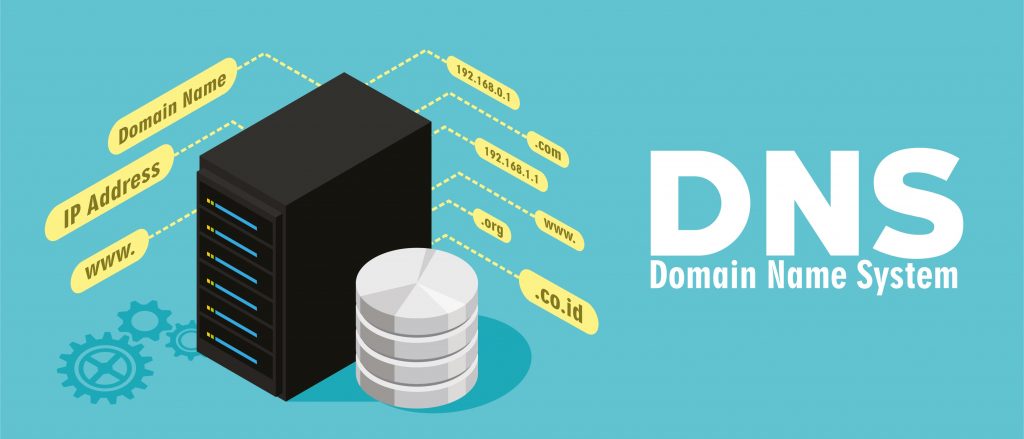Route 53
Organizations that have migrated into the AWS cloud require a cost-effective way to translate client requests into IP addresses for connecting to AWS resources, such as EC2 instances, S3 buckets, and Elastic Load Balancers. Amazon Route 53 is a scalable, reliable, and resilient Domain Name System (DNS) of the AWS that translates human-readable domain names into computer-readable numeric IP addresses. For example, if your website domain name is www.mydomain.com, Route 53 translates the address into a format like 192.168.2.1.
Route 53 traffic flow helps efficient and optimal traffic routing and fail-over during disasters. It supports the translation of domain names into IPV4 and IPV6 addresses and is the only AWS service that provides 100% availability.
Fig1: Route 53 resolves domain names into numeric IP addresses
Amazon Route 53 Architecture
Route 53 consists of DNS records that map domain names to different AWS and non-AWS resources. For instance,
- A record maps IPV4 addresses,
- AAA record maps IPV6 addresses.
- CNAME maps a hostname to another hostname
- Alias record maps a hostname to another AWS resource.
Each DNS record specifies the domain name, corresponding IP address, routing policy, and the TTL (Time To Live) Value.
When a user initially accesses a registered domain by typing its URL through a web browser, The Internet Service Provider (ISP) will route the request to the DNS resolver. The DNS resolver then forwards the domain name request to a DNS root name server. It then forwards to request to the Top-Level Domain Name server (TLD) and then to Route 53, which will send the associated IP address of the DNS record to the DNS resolver. The DNS resolver will typically cache the Route 53 name servers for two days. Therefore, the resolver can find the appropriate web server for subsequent requests directly without going through the DNS root name server and TLD.
Route 53 Use Cases
DNS Registration
Route 53 also provides Domain Name Registration from which you can purchase and manage domain names. When a user registers a domain name with Route 53, it will create a hosted zone that specifies the traffic routing for domains and sub-domains. Then, it will allocate name servers to the hosted zone and add them to your domain.
Traffic Routing
Amazon Route 53 offers several routing policies that specify how it responds to the DNS queries. The simplest routing policy is simple routing which can route traffic to a single resource. In contrast, the Multi-value routing policy enables routing to multiple resources. Weighted routing enables routing different percentages of traffic to different resources. Latency-based routing routes traffic based on the latency of the resources allowing to serve for traffic with low latency. If users need to route traffic based on the user location, the Geolocation routing policy enables them to achieve it. Geoproximity routing is another policy that allows traffic routing based on the user location bias.
Fig3: Route 53 Geo-location based routing
Fig4: Route 53 Weight-based Routing
Perform Health Checks and DNS Fail-Over
Users can associate routing policies with health checks that continuously monitor the health of their resources. It also allows users to get notifications when a resource becomes unhealthy and automatically failover to secondary resources when no healthy resources are available in the primary availability zone.
How have organizations utilized Route 53 to simplify their businesses?
A plethora of companies worldwide have leveraged the intelligent routing capabilities of Route 53 for cost-effective traffic routing. For example, ZALORA, the largest online fashion company in Southeast Asia, uses Route 53 as its domain name service and many other cloud services. Its cloud solution with Route 53 has provided them a wide range of benefits, including the ability to support their websites with approximately 30 million users per month.
Lonely Planet is another company that leverages Route 53 for its shared publishing platform for distributing traffic for related IP addresses. Its cloud solution, which consists of Route 53, has enabled Lonely Planet to save the costs of running the shared publishing platform in a data center by 30%.
A popular retail company Zappos uses an analytics and machine learning platform built on AWS for providing a better customer experience. While using microservices, autoscaling, and Elastic load balancers in its cloud architecture, the company also uses Route 53 for traffic routing. Their cloud solution has provided them many benefits, including reducing the search latency below 48 milliseconds for 99% of their search traffic, offering improved customer experience, and increasing search-to-clickthrough rates.
Summary
Route 53 is Amazons’ Domain Name Service that allows organizations to register domains, resolve domain names into IP addresses and perform health checks for registered targets. It supports different types of traffic routing, enabling organizations to efficiently distribute traffic for their AWS resources. As discussed in this article, many companies have gained multiple benefits by using Route 53 for traffic routing. Leverage the power of Route 53 for your company and receive the benefits of a highly available, cost-effective, and reliable Domain Name Service.

Resources such as the one you mentioned here will be extremely helpful to myself! Ill publish a hyperlink to this web page on my personal blog. Im certain my site visitors will discover that very useful.